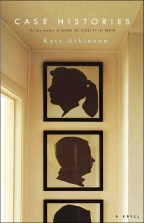Case Histories
Kate Atkinson
Little, Brown and Company, Time Warner Book Group
US Hardback
ISBN: 0-316-74040-3
Publication date: November 2004
Date Reviewed: 10 May 2005
Reviewed by: Nazalee Raja © 2005

REFERENCES
COLUMNS
|
|
|
Case HistoriesKate AtkinsonLittle, Brown and Company, Time Warner Book GroupUS HardbackISBN: 0-316-74040-3Publication date: November 2004Date Reviewed: 10 May 2005Reviewed by: Nazalee Raja © 2005 |
|
|
REFERENCES |
COLUMNS |
Stop and think for a moment about the worst thing that could possibly happen, either to you or to your loved ones: something so horrendous and momentous that continuing with ‘normal’ life afterwards seems inconceivable. Kate Atkinson’s fourth novel gives us four scenarios of just this type: three initial case histories presented at the beginning of the book and revisited at the end, and a fourth case history revealed towards the end of the novel relating to Jackson, the private investigator hired to investigate the initial three cases.
As Jackson delves in to the past, exploring the background to the mysterious disappearance of three-year-old Olivia from her own family garden, the seemingly random stabbing of eighteen-year-old Laura in her father’s law offices, and the events surrounding an axe murder at an idyllic country cottage, the reader gains insight into the fractured lives of those closest to the tragedies.
“Case Histories” contains the usual elements of a mystery genre novel. The events surrounding each case history create an initial intrigue. The reader is able to identify clues along with red herrings as both are uncovered by Jackson during the investigation. But this is not a standard mystery novel. The reader soon becomes aware that the culprits’ identities are secondary to the real focus of the novel – an exploration of grief, loss and victimhood, of the premise that those outliving such tragic circumstances must perforce become victims themselves.
Atkinson’s aim is to showcase the strength and durability of human spirit which propels people towards their future, even when they feel they have none. This novel illustrates the courage and determination required following events which cause lives to implode, and ultimately how survival, redemption, and even happiness, are possible with time and determination.
The novel follows the present-day lives of the battle-scared survivors. Each chapter is told from the point of view of one of the protagonists, so that points of view alternate and the accounts are not always chronological. This device draws the reader into the story by following a particular character’s thought processes and actions, then revealing how others in the story perceive them. It presents the reader with a panoramic view of events and characters, and helps maintain pace and interest. The result is that all the characters, even fairly minor ones, are fully realised.
“ Case Histories” carries various hallmarks of Atkinson’s work in terms of style and skill. This is a well written, astute and perceptive book. It has a literary style, but as ever with Atkinson’s work, the prose is very readable. The reader is swept along by a successful narrative flow that is kindled by warmth and Atkinson’s trademark dark humour.
Similarities with previous novels end there. Atkinson’s first two novels, “Behind the Scenes at the Museum” and “Human Croquet”, have been described as family sagas, following the fortunes of a particular family from past to present, through several generations. “Case Histories” focuses on not one but four unrelated families. It does not retrace the family line, but concentrates a spot-light on the present, on how people can spend a lifetime recovering, and re-learning how to live. This very human and insightful book, which remains with the reader long after completion, is likely to appeal fans of Atkinson’s previous work, as well as those new to her writing.